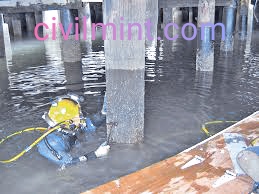Inspection of underwater concrete structures is needed for maintenance and repair work.
In this article, I have described the methods, types, and purposes of underwater concrete structure inspections.

The life of submerged concrete structures such as bridges, quays, and other marine structures is based on maintaining the physical condition of both the superstructure and substructure.
For this reason, it is important to set up and carry out proper inspection, maintenance and repair of the entire submerged concrete structure.
Testing concrete in water is usually neither easy nor economical. Therefore, it is performed less frequently than some of the structures above water. However, underwater inspection is an important part of evaluating underwater structures.
For example, various organizations, such as transportation agencies and port authorities in the United States set time intervals to perform underwater inspections as part of preventive maintenance programs.
This article discusses the reasons for performing underwater inspections, the factors to consider when conducting inspections, the purpose of inspections, and the different levels of inspections.
Table of Contents
Why Inspection is Required for Underwater Concrete Structure?
Apart from inspection for maintenance purposes, it can be done in certain situations such as new loading conditions, modifications or extensions to structures and newly constructed structures to ensure that structures are built to applicable specifications and contract documents.
Underwater inspection can be done as a requirement once the new owner purchases the structure.Underwater inspection is required in the event of a catastrophic event. B. Earthquakes, ship collisions, hurricanes, floods.
Considerations When Conducting Underwater Inspections of Concrete Structures
Below are factors to consider when inspecting underwater concrete structures.
- Design considerations
- Existing operation, inspection and maintenance records
- Condition survey
- Field test
- Certain factors that led to structural deterioration.
Purpose of Underwater Inspection of Concrete Structures
Inspections are generally performed to obtain the data necessary to assess structural conditions and indicate whether the structure meets design requirements and future performance.
Structural safety is the primary reason for conducting underwater inspections.The type of inspection indicates the amount of data that must be provided and the general goal of the study criteria.
Levels of Underwater Concrete Structures
There are three types or levels of underwater surveys used to evaluate offshore structures. They differ in the amount of work required and the techniques or means by which the task is accomplished.The planning phase determines the level of inspection used for a particular inspection. The following sections describe three types of underwater testing.
- Level I – general underwater visual inspection
- Level II – Close level underwater inspection
- Level III – very detailed underwater inspection
Let’s know about these three levels in detail.
Level I – general underwater visual inspection
This inspection level is the fastest method among all other inspection levels because this method does not require the structure to be cleaned during the execution of this inspection level.
A general underwater visual inspection serves a variety of purposes such as Confirm as-built condition, generate initial data for establishing an inspection program, and find any obvious deterioration or damage that may have occurred as a result of impact, abuse, corrosion, or biological attack.
Level II – Close level underwater inspection
Concrete surfaces should be cleaned before or during close-up underwater inspections. This method is used to identify and identify issues that are obscured or hidden by marine plants. Also, since cleaning a structure takes a lot of time, cleaning is usually applied at critical points in the structure.
In this method, the amount of information used to assess the initial strength of concrete structures and members is insufficient and limited.
The amount and quality of cleaning depends on the amount of information required to create an overall assessment of the structure.
Level III – very detailed underwater inspection
Level III underwater testing is used to look for hidden or imminent damage and to determine material homogeneity. Therefore, before starting the inspection, the surface of concrete structures or elements should be cleaned.
